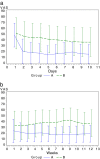Pain response of resistance training of the paravertebral musculature under radiotherapy in patients with spinal bone metastases--a randomized trial
- PMID: 24996223
- PMCID: PMC4094419
- DOI: 10.1186/1471-2407-14-485
Pain response of resistance training of the paravertebral musculature under radiotherapy in patients with spinal bone metastases--a randomized trial
Abstract
Background: To compare pain response outcomes for patients with spinal bone metastases treated with resistance training of the spinal musculature versus passive physical therapy during radiotherapy (RT).
Methods: In this randomized trial, 60 consecutive patients were treated from September 2011 until March 2013 within one of the two groups: resistance training (Arm A) or passive physical therapy (Arm B) with thirty patients in each group during RT. The course of pain according to visual analog scale (VAS), concurrent medication, and oral morphine equivalent dose (OMED) were assessed at baseline, three months, and six months after RT. Pain response was determined using International Bone Consensus response definitions.
Results: The course of VAS in the intervention group (Arm A) was significantly lower both during and after RT (AUC, p < .001). The use of analgetic medication showed the same result, with significantly fewer analgetics being necessary both during and after RT in arm A (p < .001). In the course of time, the OMED decreased in arm A, but increased in arm B. After 6 month, 72.2% of patients in arm A, and 22.2% in arm B were responders (p = .014).
Conclusion: Our trial demonstrated that guided isometric resistance training of the paravertebral muscles can improve pain relief over a 6-months period in patients with stable spinal metastases. Importantly, the intervention was able to reduce OMED as well as concomitant pain medication. The trial is registered in Clinical trial identifier NCT 01409720 (http://www.clinicaltrials.gov/) since 2nd of August 2011.
Trial registration: ClinicalTrials.gov NCT01409720.
Figures



References
-
- Coleman RE. Metastatic bone disease: Clinical features, pathophysiology and treatment strategies. Cancer Treat Rev. 2001;27:165–176. - PubMed
-
- Harrington KD. Orthopedic surgical management of skeletal complications of malignancy. Cancer. 1997;80(8):1614–1627. - PubMed
-
- Janjan N, Lutz ST, Bedwinek JM, Hartsell WF, Ng A, Pieters RS Jr, Ratanatharathorn V, Silberstein EB, Taub RJ, Yasko AW, Rettenmaier A. Therapeutic guidelines for the treatment of bone metastasis: a report from the American College of Radiology Appropriateness Criteria Expert Panel on Radiation Oncology. J Palliat Med. 2009;12:417–426. - PubMed
-
- Hayes S, Spence R, Galvao D, Newton RU. Australian association for exercise and sport science potion stand: optimising cancer outcomes through exercise. J Sci Med Sport. 2009;12:428–434. - PubMed
-
- Mitera G, Probyn L, Ford M, Donovan A, Rubenstein J, Finkelstein J, Christakis M, Zhang L, Campos S, Culleton S, Nguyen J, Sahgal A, Barnes E, Tsao M, Danjoux C, Holden L, Yee A, Khan L, Chow E. Correlation of computed tomography imaging features with pain response in patients with spine metastases after radiation therapy. Int. J Radiation Oncol Biol Phys. 2011;81(3):827–830. - PubMed
Publication types
MeSH terms
Associated data
LinkOut - more resources
Full Text Sources
Other Literature Sources
Medical

